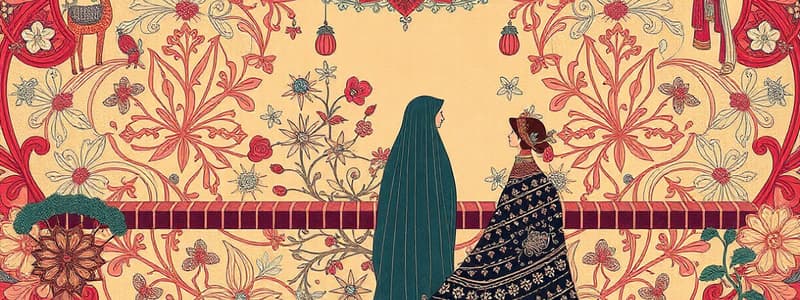Podcast
Questions and Answers
What is the primary focus of consumer behavior studies?
What is the primary focus of consumer behavior studies?
- The processes consumers use to make purchase decisions and product use (correct)
- The impact of advertising on societal values
- The financial implications of consumer spending
- The psychological analysis of consumer emotions
Why should marketing managers carefully study consumer behavior?
Why should marketing managers carefully study consumer behavior?
- To align products/services with changing consumer preferences (correct)
- To minimize production costs
- To control consumer preferences
- To predict economic recessions
Which of the following is the first step in the consumer decision-making process?
Which of the following is the first step in the consumer decision-making process?
- Purchase
- Need Recognition (correct)
- Evaluation of Alternatives
- Information Search
What is 'Need Recognition' primarily driven by?
What is 'Need Recognition' primarily driven by?
What role does marketing play in 'Need Recognition'?
What role does marketing play in 'Need Recognition'?
What is the primary difference between an internal stimulus and an external stimulus in need recognition?
What is the primary difference between an internal stimulus and an external stimulus in need recognition?
Which of the following situations could trigger 'Need Recognition'?
Which of the following situations could trigger 'Need Recognition'?
What are the two main sources consumers use in the information search stage?
What are the two main sources consumers use in the information search stage?
What is Internal Information Search?
What is Internal Information Search?
In which scenario would a consumer be more likely to engage in an External Information Search?
In which scenario would a consumer be more likely to engage in an External Information Search?
What is meant by 'Evoked Set' in the context of consumer behavior?
What is meant by 'Evoked Set' in the context of consumer behavior?
In the evaluation of alternatives, what is the role of 'cutoff criteria'?
In the evaluation of alternatives, what is the role of 'cutoff criteria'?
How do marketing managers use product attribute analysis?
How do marketing managers use product attribute analysis?
What is the ultimate decision a consumer faces in the purchase stage?
What is the ultimate decision a consumer faces in the purchase stage?
What is cognitive dissonance?
What is cognitive dissonance?
How can consumers reduce cognitive dissonance after a purchase?
How can consumers reduce cognitive dissonance after a purchase?
Which marketing strategy can help minimize cognitive dissonance?
Which marketing strategy can help minimize cognitive dissonance?
What does 'customer involvement' refer to in the context of buying decisions?
What does 'customer involvement' refer to in the context of buying decisions?
What characterizes 'Routine Response Behavior'?
What characterizes 'Routine Response Behavior'?
Which type of buying decision typically involves a longer time to decide and evaluation of many brands?
Which type of buying decision typically involves a longer time to decide and evaluation of many brands?
A consumer is considering buying a new car. Which type of consumer buying decision are they most likely to use?
A consumer is considering buying a new car. Which type of consumer buying decision are they most likely to use?
Which of the following factors does not typically determine the level of involvement in a purchase decision?
Which of the following factors does not typically determine the level of involvement in a purchase decision?
How should marketing strategies differ for high-involvement versus low-involvement products?
How should marketing strategies differ for high-involvement versus low-involvement products?
Which of the following is an example of a cultural factor that can affect the consumer decision journey?
Which of the following is an example of a cultural factor that can affect the consumer decision journey?
How is 'culture' defined in the context of consumer behavior?
How is 'culture' defined in the context of consumer behavior?
What are some social influences?
What are some social influences?
What is a 'Reference Group'?
What is a 'Reference Group'?
Which of the following is an example of a direct reference group?
Which of the following is an example of a direct reference group?
Which of the following describes an aspirational reference group?
Which of the following describes an aspirational reference group?
What is the role of an 'Opinion Leader'?
What is the role of an 'Opinion Leader'?
How are marketers leveraging online media to engage with opinion leaders?
How are marketers leveraging online media to engage with opinion leaders?
How does 'Age and Family Life Cycle stage' affect consumer tastes and preferences?
How does 'Age and Family Life Cycle stage' affect consumer tastes and preferences?
How does personality combine to influence a customer?
How does personality combine to influence a customer?
What psychological influences a customer?
What psychological influences a customer?
Which of the following describes what could be included in a customer's self-concept?
Which of the following describes what could be included in a customer's self-concept?
A homogeneous group of people who share elements of the overall culture as well as unique elements of their own group could best be described as?
A homogeneous group of people who share elements of the overall culture as well as unique elements of their own group could best be described as?
Which of the following is not a typical way to measure a social class?
Which of the following is not a typical way to measure a social class?
Flashcards
Consumer Behavior
Consumer Behavior
The process a consumer uses to make purchase decisions, use, and dispose of goods/services, influenced by various factors.
Consumer Decision-Making Process
Consumer Decision-Making Process
A multi-step process consumers follow when buying goods or services.
Need Recognition
Need Recognition
The first stage in the consumer decision-making process, where a consumer recognizes a difference between their current state and desired state.
Want
Want
Signup and view all the flashcards
Internal Information Search
Internal Information Search
Signup and view all the flashcards
External Information Search
External Information Search
Signup and view all the flashcards
Evoked Set
Evoked Set
Signup and view all the flashcards
Cognitive Dissonance
Cognitive Dissonance
Signup and view all the flashcards
Routine Response Behavior
Routine Response Behavior
Signup and view all the flashcards
Limited Decision Making
Limited Decision Making
Signup and view all the flashcards
Extensive Decision Making
Extensive Decision Making
Signup and view all the flashcards
Culture
Culture
Signup and view all the flashcards
Subculture
Subculture
Signup and view all the flashcards
Social Class
Social Class
Signup and view all the flashcards
Reference Group
Reference Group
Signup and view all the flashcards
Direct Face-to-Face Membership
Direct Face-to-Face Membership
Signup and view all the flashcards
Indirect Nonmembership
Indirect Nonmembership
Signup and view all the flashcards
Opinion Leader
Opinion Leader
Signup and view all the flashcards
Product Attributes
Product Attributes
Signup and view all the flashcards
Study Notes
- Consumer Behavior encompasses the processes consumers use to make purchase decisions, use, and dispose of goods/services, including influencing factors.
- Understanding consumer behavior is crucial due to constantly changing product and service preferences.
- Marketing managers use this to study how consumers behave relative to their product or service.
- This understanding helps in developing a desirable marketing mix includes product, price, promotion, and placement.
- The Consumer Decision-Making Process consists of five steps used when buying goods or services, these steps are affected by cultural, social, individual, and psychological factors.
Consumer Decision-Making Process Steps
- Need Recognition
- Information Search
- Evaluation of Alternatives
- Purchase
- Post-purchase Behavior
Case of Buying a New Car
- Ms. Goodman is a City College teacher of ten years.
- She commutes daily from North Bay.
- She owns a Mazda convertible that gets poor gas mileage.
- The car lease ends in a month, signaling time for a new vehicle.
- The current car doesn't fit her three grown sons
- Debbie suggested Goodman consider a hybrid for its gas mileage.
- Ms. Goodman has seen electric cars displayed at the mall.
- Her husband proposes a more professional car image because of her commute and job.
- Ms. Goodman wants something sporty and big enough for her three sons.
- Ms. Goodman loves teaching but lives on a teacher's salary
Need Recognition
- Need Recognition is the result of an imbalance between current and desired states.
- A want is a new way a consumer addresses the need.
- Consumers recognize an imbalance between their present status and preferred state through Internal or External stimuli.
- Internal stimuli are occurrences someone experiences such as hunger, thirst, etc.
- External Stimuli – Influences from the outside include package design, ads/brand name Recommendation from a friend and Friend recommendations, Car dealerships in the mall, Online search, Trend toward driving an electric car
- Ms. Goodman's need recognition stems from her lease ending, poor gas mileage, lack of room, image and cost.
- A need can arise when a product isn't performing well, when the consumer is running out of the product, or another product appears superior.
Information Search
- Internal Information Search is recalling information stored in memory which is sufficient for frequently purchased products
- External Information Search is needed when past knowledge is insufficient and if there may be a wrong purchase decision.
- Sources for external search include personal sources, public sources, and marketer-dominated sources.
- Mrs. Goodman's internal information searc:
- Hondas and Toyotas get great gas mileage
- Prius has a new roomy model and Nissan Leaf ads.
- Leasing another convertible is a good deal.
- She's been in Debbie's Honda hybrid insight is nice.
- A Tesla would give her the image she want.
- Her external information search will involve
- Educating about hybrid/electric cars
- Consulting consumer reports
- Searching the Internet for hybrids
- Asking Charlie, who drives an electric car.
- Paying attention to hybrid car ads/showrooms
- Less information is needed when there is Less Risk or if There is More knowledge, more product experience, Low level of interest and Confidence in decision
- More Information is needed when there is More Risk or if there is Less knowledge Less product experience, High level of interest and Lack of confidence
Evaluation of Alternatives
- The Evoked Set is a group of brands that result from an information search that a buyer can choose from.
- Analyze product attributes
- Use cutoff criteria
- Rank attributes by importance
Analyzing Product Attributes
- The goal of the marketing manager is to determine which attributes have the most influence on a consumer's choice and design a marketing mix that stresses those attributes to the consumer.
- Key product attributes include:
- Fuel Efficiency
- Size/horsepower
- Performance
- Entertainment features
- Navigation features
- Safety
- Appearance & Comfort
- Reliability
- Affordability
- Energy Efficiency
- Versatility
- Pro-environmentalist
Use Cut-Off Criteria
- Cut-off criteria would include:
- Gas mileage (60 MPG)
- Size
- Cost (under $40,000)
- Reliability
- Entertainment features
- Cute and Sporty
- Navigation features
- Environment
Ranking Attributes by Importance
- Typical rankings can include:
- Gas mileage
- Sporty and cute
- Size
- Navigation features
- Entertainment features
- Toyota's hybrid market has been segmented according to buyer behavior (pro-environmentalists, those wanting great gas mileage ie. 50 miles per gallon, those who want Sexy, cute, sporty, fun)Toyota ads are segmented by the buyer market that they are trying to attract.
- Marketers will determine product attribute analysis in their marketing jobs.
Purchase
- Ultimately, the consumer must decide whether to buy or not.
- Factors to consider in a purchase include:
- Whether to buy
- When to buy
- What to buy (product type/brand)
- Where to buy (retailer, online)
- How to pay
- When buying products, customers expect certain outcomes from the purchase.
Post-Purchase Behavior
- Cognitive Dissonance is inner tension that a consumer experiences after recognizing an inconsistency between behavior and value or opinions.
- Consumers can reduce dissonance by Seeking information that reinforces positive ideas about the purchase.
- Consumers can reduce dissonance by Avoiding information that contradicts the purchase decision
- Consumers can reduce dissonance by Revoking the original decision by returning the product Marketing can minimize dissonance through Communication, Follow-up, Guarantees and Warranties.
Types of Consumer Buying Decisions
- Customer involvement determines the type of buying decision made by a consumer
- Routine Response Behavior is used for Frequently purchased, low-cost goods where the consumer may stick with one brand and make a quick decision with little involvement in the selection process
- Limited Decision Making has low levels of involvement that can lead to Evaluating a few alternative brands in a moderate amount of time
- Extensive Decision Making refers to High levels of involvement with High cost goods that can have one experiencing Cognitive dissonance.
- The Continuum of Consumer Buying Decisions ranges from Routine to Limited and all the way to Extensive
Level of Involvement
- Five factors determining the level of involvement include:
- Previous experience with the product
- Interest
- Perceived risk of negative consequences
- Financial risk
- Social risk
- Psychological risk
- Psychological visibility
- High Involvement calls for Extensive and informative promotions that Highlight benefits, advantages, uses, customization and unique options
- Low Involvement calls, the need to Remember consumers may not know they need, until in the store, In-store promotions are important and
- Package design eye-catching, easy to read, recognized
- Coupons, cent-off deals, 2-for-1 to incent trial
- Marketing strategy varies according to the level of involvement with the product.
Factors Affecting the Consumer Decision Journey
- Social Factors such as Reference groups, Opinion leaders and Family
- Individual Factors which include: Gender, Age and family life cycle stage and Personality, self-concept, and lifestyle
- Cultural Factors that include Culture and values, Subculture and Social class
- Psychological Factors include Perception, Motivation, Learning and Beliefs and attitudes
Culture and Values
- Culture are values, norms, attitudes, and other meaningful symbols that shape human behavior and the artifacts, or products, of that behavior as they are transmitted from one generation to the next.
- Subculture is a homogeneous group of people who share elements of the overall culture as well as unique elements of their own group.
- Social Class is a group of people in a society who have equal status or community esteem, who socialize both formally and informally, and who share behavioral norms.
- Social Class Measurements include Occupation, Income, Education, Wealth, Other Variables
Social Influences
- Reference Groups is a group in society that influences an individual's purchasing behavior.
- Opinion Leaders influence the opinion of others.
- Family Members are broken up into Initiators, Influencers, Decision Makers, Purchasers, Consumers.
Types of Reference Groups
- Direct Face-to-Face Membership:
- Primary: small, informal group
- Secondary: large, formal group
- Indirect Nonmembership:
- Aspirational Group that someone would like to join
- Nonaspirational Group with which someone wants to avoid being identified
- Opinion Leaders are the first to try new products and services out of pure curiosity, who can be challenging to locate, Marketers are increasingly using blogs, social networking, and other online media to determine and attract opinion leaders.
Individual Influences
- Individual influences include: Gender Age, Life Cycle and Personality, Self-Concept and Lifestyle
- Marketers define target markets according to life cycle stages such as "young singles" or "young married with children.
- Personality combines psychological makeup and environmental forces.
- Human behavior depends largely on self-concept.
- Self-concept combines ideal self-image real self-image.
Psychological Influences
- Psychological Influences include: Perception, Motivation, Learning and Beliefs & Attitudes
Studying That Suits You
Use AI to generate personalized quizzes and flashcards to suit your learning preferences.



